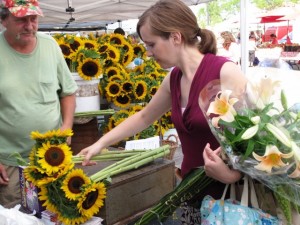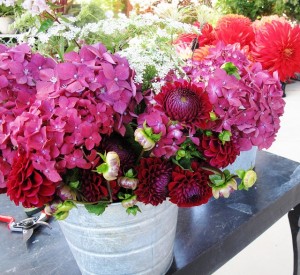How to choose the freshest bouquets and flowers at your local farmers’ market
May 14th, 2013

Field-grown peonies should be selected at the “marshmallow” stage, when the heads have just a little give when squeezed.
Forget flowers grown far from home. You’ll find the best blooms right in your own neighborhood – straight from a local flower farmer.
The growth of local farmers’ markets is staggering – up 17 percent nationwide in 2011, according to the USDA (USDA Farmers’ Market Data). And as more farmers’ markets establish in communities across the U.S., you can be certain to find more beautiful flower stalls, which is great news for the DIY floral designer, hostess and nature- lover.
When you shop at a weekly farmers’ market, look for fresh, seasonal and uncommon floral crops – you’ll be wowed by the selection and quality. Yes, it’s fun to meet the people who grow these blooms. But you can also learn from their experience and knowledge — ask your flower farmer for tips on how to care for their beautiful stems at home. Here are some of the best ways to enjoy farmers’ market flowers and extend their vase life:
Selection: Most farmers harvest their crops as close to market day as possible, ensuring very fresh varieties – straight from the field. Shop early in the morning for the best choice (plus, flowers are always happier when it’s cooler!). If the market is in an uncovered location, expect to see large awnings or umbrellas to keep the floral products out of direct sun. Look at the stall’s hygiene – are the buckets clean and filled with fresh water? Be sure to ask “Where is your farm?” and “Why type of growing practices do you use?” – let the vendor know you appreciate sustainable practices.
What to look for:
-

Chicago floral designer Lynn Fosbender, owner of Pollen Flowers, relies on Midwest flower farmers for her summertime vase arrangements and bouquets.
When choosing a mixed bouquet, look at all the ingredients to see that they are equally fresh. The focal flowers, softly-textured delicate elements and foliage should feel plump; not wilted or limp. When selecting a straight bunch, often called a “grower’s bunch,” check that all the stems are similar in length and all the blooms are similar size.
- Flower heads should be relatively tight on most varieties, ensuring that they will continue to open in the vase on your dining table.
- Some flowers, such as dahlias, do not open further once cut, so what you see is what you get. Others, like zinnias, can be fully open and they’ll last well over a week.
- With lilies, such as Stargazer or the Asiatic varieties, choose stems with plump, tight buds and possibly only one full bloom – you’ll have more than a week of enjoyment as those flowers open in succession.
- Sunflowers should be about half or two-thirds open and will soon look fuller as their petals unfurl in the vase.
- Tulips should have a tight head with the tips of the foliage as tall as possible (if the tulip head is far above the foliage tips, it means the flowers have been in water for several days, as the stems continue to “grow”).
- Daffodils that are tight in bud will open beautifully to a full trumpet shape indoors.
- Peonies should be in the “marshmallow” stage (squeeze the bud gently and you’ll feel a spongy quality – like a marshmallow). If you buy fully-opened peonies, they won’t last long at home.
- Garden roses should not have tight heads or fully-opened heads; look for a partially open rose head.
- Tall or spiked flowers, such as delphiniums, gladiolas and snapdragons, should have tight or closed buds along the top one-third of the stem, with the lower two-thirds in bloom; those upper-most buds will open in your vase.
- Lilacs are not known for lasting more than 5 days or so – but their intoxicating fragrance makes up for their shorter vase life. Pick lilacs with the top florets still in bud.
- Hydrangeas should be almost fully open and they will need lots of fresh water – up to their necks in a vase – to ensure that the entire stem is hydrated.
- All stems should be clean, stripped of their bottom foliage, and not slimy. Any remaining leaves should be fresh and un-bruised.

When properly cared for, locally-sourced flowers will last much longer in the vase than anything that’s imported.
Care for your flowers at home:
I’m always surprised when my workshop students ask: “How long will these flowers last in a vase?” I like to respond by asking: “How long do you enjoy a bottle of wine?” or “How long does it take to eat a farm-to-table meal at your favorite restaurant?”
The answer is usually: 45 minutes! We seem to be satisfied that our food and wine give us less than one hour of pleasure, but we expect flowers to do the hard work of looking awesome for more than a week! Adjust your expectations and be happy with the moment. Some flowers are so delicate they just don’t last that long once cut. But it doesn’t minimize my enjoyment one bit! In general, farmer’s market floral varieties will last 5 to 7 days.
- Bring your flowers home as quickly as possible from the farmer’s market. The longer those bunches sit in your car while you run errands, the quicker they will begin to decline in freshness.
- Open up the bunch; remove and dispose of twist-ties or rubber bands. Wear protective gloves if you are working with thorny roses.
- I like to process one stem at a time, with a large vase or clean bucket of water nearby. Working from just under the flower head and sliding your hand down the stem, strip off any excess foliage. It’s nice to leave a few green leaves at the top, near the bloom. Some leaves are not strippable this way and will need to be plucked or clipped off, one at a time by hand. Discard all foliage waste in a compost bin.
- Re-cut all stems using a clean, sharp floral knife, floral snips or pruning shears (for woody stems). Cut at a 45-degree angle and immediately place stems in your bucket or vase of water. Place the flowers in a cool, dark place and let them hydrate for a few hours before arranging.
- If any flowers need extra reviving, give them a cool “bath” in the sink or tub, laying a hand towel on top to keep them submerged. After about 15 minutes, lift the stems out of the bath and tie them loosely in a bunch; hang that bunch from the shower head or curtain rod to let more moisture move into that flower head. This trick often works for hydrangeas and perennials with wilted necks.
- You do not need to smash or twist woody stems, as was once believed useful. According to professors Lane Greer and John M. Dole, authors of Woody Cut Stems for Growers and Florists, a research-based reference, the practice “has never been proven to extend vase life.” The best thing you can do is to use clean, sharp pruners and refresh the vase water every day or two.
- Use a clean, watertight vessel and fresh water. I don’t rely on florist’s food or any other home remedy. The best thing you can do is keep your bouquet away from any source of heat, out of direct sunlight, and refresh the vase water.
- If it’s possible to re-cut stems when you change the water, do so (cut 1/2-inch from the bottom of all stems). If your arrangement is a tangle and seems impossible to reconstruct, try this tip: Place the entire arrangement in the kitchen sink. Gently lift the foliage at one edge of the vase so the faucet’s spray nozzle is directed inside. Turn on the water and let it flow for a minute or two. The existing water will begin to overflow and go down the drain, displaced by fresh water that now occupies the vase (dry off the bottom and outside of the container when finished). Do this every day or two for the life of the arrangement.

Gretchen Hoyt, one of my favorite farmers, sells sustainably-grown tulips at Seattle’s Pike Place Market
Flower farmers are the floral world’s new rock stars! When we support local American flower farmers, we’re helping save agricultural land, encourage rural economic development and create living wage farm jobs. These hardworking farmers are eager to tell you their stories and introduce you to annuals, perennials and other seasonal botanical ingredients that will inspire your own creativity. Some farms accommodate U-pick customers; others work closely with wedding parties to custom-grow flowers for the DIY couple. If you can’t find a local flower farmer in your community, check these resources:
Association of Specialty Cut Flower Growers, www.ascfg.org. Click on the “Grower” tab to search state by state.
Local Harvest, www.localharvest.org lists farmers’ markets across the country.









May 14th, 2013 at 8:49 am
[…] How to choose the freshest bouquets and flowers at your local farmers’ market […]
May 15th, 2013 at 6:30 am
Good tips, thank you!
November 19th, 2018 at 10:26 am
I love everything about your tips! Great ideas! Thanks for sharing!